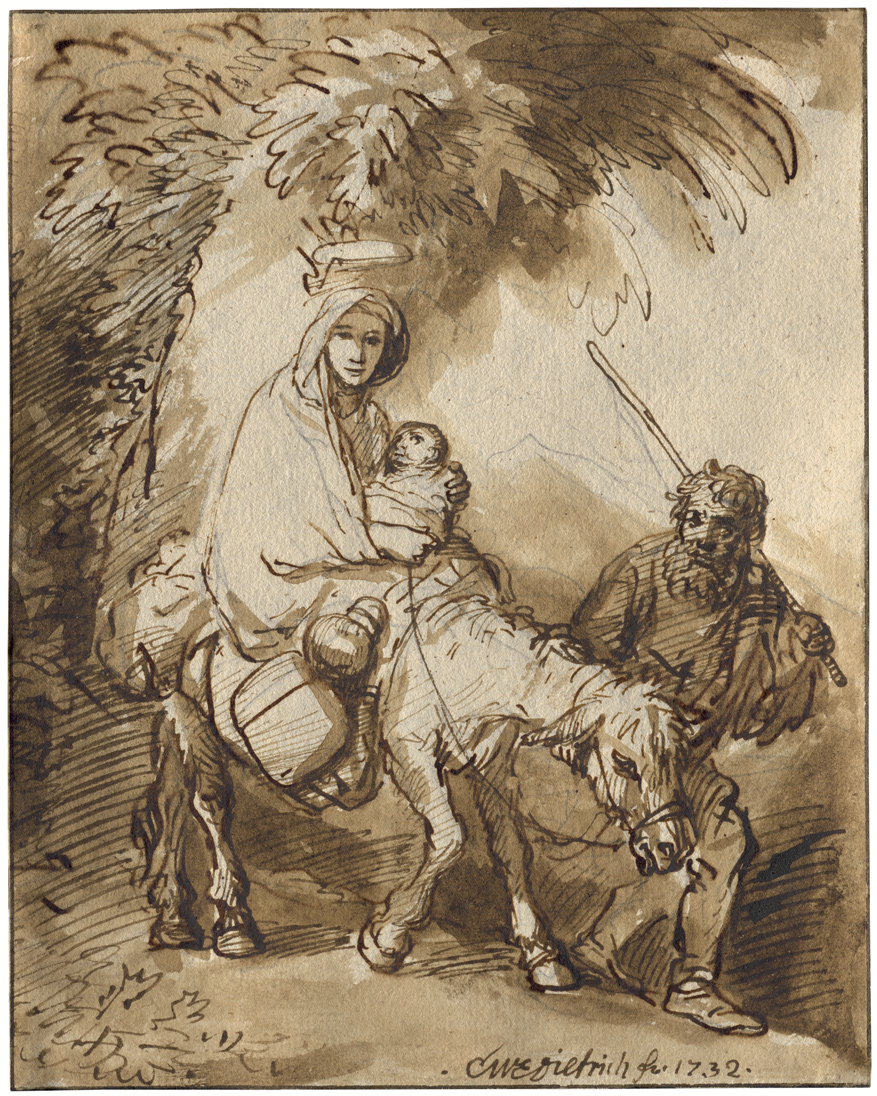Loading the page ...
Christian Wilhelm Ernst Dietrich
(known as Dietricy, 1712 Weimar – 1774 Dresden)
The Flight into Egypt. Pen and brown ink over a light preliminary drawing in graphite, brown wash; framing line in pen and brown ink; verso with a graphite sketch of the Supper at Emmaus. 19.2 x 15.2 cm. Signed and dated: “C.W. E. Dietrich fe. 1732”.
The Flight into Egypt is an early masterpiece by Christian Wilhelm Ernst Dietrich, even though he was just twenty years old when he made this brilliant drawing. The work is an outstanding example of the successful adaptation of a pictorial tradition, for the composition rests largely on an etching on the same theme made by Rembrandt in 1654 (Bartsch 55; The New Hollstein 277). In his early years Dietrich was greatly influenced by Rembrandt. His recourse to the great Dutch predecessor was symptomatic of a rediscovery and new appreciation of the master which commenced in Germany in the first half of the 18th century. Dietrich must have been familiar with original drawings by Rembrandt; the dynamic, greatly foreshortening linework and the flowing, subtly nuanced washes are inconceivable without the example he set. The drawing probably served as a design for an etching by Dietrich (Linck 13) which he made a little later and reproduces the composition in reverse. In this scene Dietrich added a hovering angel holding a torch to light the path of the Holy Family.
Christian Dietrich received his initial artistic tuition from his father, Johann Georg, a painter and printmaker at the court in Weimar. He subsequently enrolled at the Dresden Academy, where he studied under the landscape painter, Alexander Thiele. The latter recommended his pupil to the Elector of Saxony, Augustus the Strong, to whom Dietrich became court painter in 1731. Two years later the artist, who had called himself Dietricy since the 1730s, undertook a one-year study trip to Italy. In 1748, Dietrich was appointed Inspector of the Dresden Art Gallery, a development which coincided with a very productive period in his artistic work. A further honourable appointment followed in 1763, when Dietrich was offered a professorship at the Dresden Academy.
Dietrich’s paintings, drawings and prints are a perfect example of the cavalier eclecticism of his time. He absorbed the artistic idioms of the various 17th and 18th century schools, assimilating in his works influences of the Dutch Italianates as well as ideas taken from Rembrandt, Rubens, Watteau, Titian, Ricci and Rosa. The drawing has a complete provenance going back to its creation in 1732: Valerius Röver (1686–1739, Lugt 2984 a–c), with his inventory numbers; Cornelis Ploos van Amstel (1726–1798, Lugt 3002–3004); Philippe van der Schley, Amsterdam, 3 March 1800, Kunstboek X Part of Lot 60 (“De Vlugt naar Egipten; met de Pen en Roet, door C. W. E. Dietrichi ..”); Herman de Kat (1784–1865); Lamm, Rotterdam, 4–8 March 1867, Lot 8 (“La Fuite en Egypte. Au bistre”; 1.25 guilders to de Clercq; Henry Duval; Frederik Muller et Cie., Amsterdam, 22–23 June 1910, Lot 90; A. Mos; R. W. P. de Vries, Amsterdam, 7. – 8. November 1928, acquired there by I. Q. van Regteren Altena (Lugt 4617).
